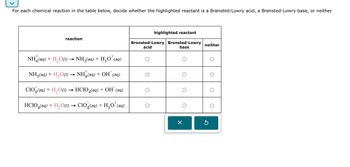
Chemistry: The Molecular Science
5th Edition
ISBN: 9781285199047
Author: John W. Moore, Conrad L. Stanitski
Publisher: Cengage Learning
expand_more
expand_more
format_list_bulleted
Question
Please help with identifying these.

Transcribed Image Text:For each chemical reaction in the table below, decide whether the highlighted reactant is a Brønsted-Lowry acid, a Brønsted-Lowry base, or neither.
reaction
-
NH(aq) + H2O(l) → NH3(aq) + H₂O*(aq)
NH3(aq) + H2O(l) → NH¼4(aq) + OH¯ (aq)
highlighted reactant
Bronsted-Lowry Bronsted-Lowry neither
acid
base
ClO4(aq) + H2O(l)
→
HClO4(aq) + OH (aq)
HCIO4(aq) + H2O(l) → ClO4(aq) + H₂O* (aq)
-
Х
Expert Solution
This question has been solved!
Explore an expertly crafted, step-by-step solution for a thorough understanding of key concepts.
Step by stepSolved in 2 steps

Knowledge Booster
Similar questions
- In each of the following acid-base reactions, identify the Brnsted acid and base on the left and their conjugate partners on the right. (a) C2H5N(aq) + CH3CO2H(aq) C5H5NH+(aq) + CH3CO2(aq) (b) N2H4(aq) + HSO4(aq) N2H5+(aq) + SO42(aq) (c) [Al(H2O)6]3+ (aq) + OH(aq) [Al(H2O)5OH]2+ (aq) + H2O+()arrow_forwardWhich acid has the strongest conjugate base? (a) HNO2 (b) C6H5CO2H (c) HCN (d) HClarrow_forward. In each of the following chemical equations, identify the conjugate acid-base pairs. a. NH3(aq)+H2O(l)NH4+(aq)+OH(aq) b. PO43(aq)+H2O(1)HPO42(aq)+OH(aq) c. C2H3O2(aq)+H2O(l)HC2H3O2(aq)+OH(aq)arrow_forward
- (a) Which is the stronger Bronsted acid, HCO3 or NH4+? Which has the stronger conjugate base? (b) Is a reaction between HCO3- ions and NH3 product- or reactant-favored at equilibrium? HCO3(aq) + NH3(aq) CO32(aq) + NH4+(aq) (c) You mix solutions of sodium hydrogen phosphate and ammonia. The net ionic equation for a possible reaction is HPO42(aq) + NH3(aq) PO43(aq) + NH4+(aq) Does the equilibrium lie to the left or to the right for this reaction?arrow_forwardUsing the diagrams shown in Problem 10-37, which of the four acids is the weakest acid?arrow_forwardIn the following net ionic reaction, identify each species as either a Brnsted-Lowry acid or a Brnsted -Lowry base: CH3COO(aq)+HS(aq)CH3COOH(aq)+S2(aq). Identify the conjugate of each reactant and state whether it is a conjugate acid or a conjugate base.arrow_forward
- Without writing an equation, specify the molecular ratio in which each of the following acidbase pairs will react. a. HCl and KOH b. H2CO3 and KOH c. HCl and Ca(OH)2 d. H2CO3 and Ca(OH)2arrow_forwardFind the value of Kb for the conjugate base of the following organic acids. (a) picric acid used in the manufacture of explosives; Ka = 0.16 (b) trichloroacetic acid used in the treatment of warts; Ka = 0.20arrow_forwardIndicate whether the first listed reactant in each of the following BrnstedLowry acidbase reactions is functioning as an acid or a base. a. F + H2O HF + OH b. HClO + H2O H3O+ + ClO c. H3PO4 + NH3 NH4+ + H2PO4 d. HNO2 + HS H2S + NO2arrow_forward
- Predict which of these acid-base reactions are product-favored and which are reactant-favored. In each case write a balanced equation for any reaction that might occur, even if the reaction is reactant-favored. Consult Table 14.2 if necessary. (a) NH4+(aq)+HPO42(aq) (b) CH3COOH(aq) + OH(aq) (c) HSO4(aq)+H2PO4(aq) (d) CH3COOH(aq) + F(aq)arrow_forwardIndicate whether the first listed reactant in each of the following BrnstedLowry acidbase reactions is functioning as an acid or a base. a. HF + H2O H3O+ + F b. CN + H2O HCN + OH c. HCN + NO2 HNO2 + CN d. NH3 + HNO3 NH4+ + NO3arrow_forwardWrite a balanced chemical equation to represent each of the following acidbase neutralization reactions. a. HCl and LiOH b. HNO3 and Ba(OH)2 c. H2SO4 and NaOH d. KOH and H3PO4arrow_forward
arrow_back_ios
SEE MORE QUESTIONS
arrow_forward_ios
Recommended textbooks for you
 Chemistry: The Molecular ScienceChemistryISBN:9781285199047Author:John W. Moore, Conrad L. StanitskiPublisher:Cengage Learning
Chemistry: The Molecular ScienceChemistryISBN:9781285199047Author:John W. Moore, Conrad L. StanitskiPublisher:Cengage Learning Chemistry & Chemical ReactivityChemistryISBN:9781337399074Author:John C. Kotz, Paul M. Treichel, John Townsend, David TreichelPublisher:Cengage Learning
Chemistry & Chemical ReactivityChemistryISBN:9781337399074Author:John C. Kotz, Paul M. Treichel, John Townsend, David TreichelPublisher:Cengage Learning Chemistry & Chemical ReactivityChemistryISBN:9781133949640Author:John C. Kotz, Paul M. Treichel, John Townsend, David TreichelPublisher:Cengage Learning
Chemistry & Chemical ReactivityChemistryISBN:9781133949640Author:John C. Kotz, Paul M. Treichel, John Townsend, David TreichelPublisher:Cengage Learning Chemistry: Principles and PracticeChemistryISBN:9780534420123Author:Daniel L. Reger, Scott R. Goode, David W. Ball, Edward MercerPublisher:Cengage Learning
Chemistry: Principles and PracticeChemistryISBN:9780534420123Author:Daniel L. Reger, Scott R. Goode, David W. Ball, Edward MercerPublisher:Cengage Learning General, Organic, and Biological ChemistryChemistryISBN:9781285853918Author:H. Stephen StokerPublisher:Cengage Learning
General, Organic, and Biological ChemistryChemistryISBN:9781285853918Author:H. Stephen StokerPublisher:Cengage Learning Introductory Chemistry: A FoundationChemistryISBN:9781337399425Author:Steven S. Zumdahl, Donald J. DeCostePublisher:Cengage Learning
Introductory Chemistry: A FoundationChemistryISBN:9781337399425Author:Steven S. Zumdahl, Donald J. DeCostePublisher:Cengage Learning

Chemistry: The Molecular Science
Chemistry
ISBN:9781285199047
Author:John W. Moore, Conrad L. Stanitski
Publisher:Cengage Learning

Chemistry & Chemical Reactivity
Chemistry
ISBN:9781337399074
Author:John C. Kotz, Paul M. Treichel, John Townsend, David Treichel
Publisher:Cengage Learning

Chemistry & Chemical Reactivity
Chemistry
ISBN:9781133949640
Author:John C. Kotz, Paul M. Treichel, John Townsend, David Treichel
Publisher:Cengage Learning

Chemistry: Principles and Practice
Chemistry
ISBN:9780534420123
Author:Daniel L. Reger, Scott R. Goode, David W. Ball, Edward Mercer
Publisher:Cengage Learning

General, Organic, and Biological Chemistry
Chemistry
ISBN:9781285853918
Author:H. Stephen Stoker
Publisher:Cengage Learning

Introductory Chemistry: A Foundation
Chemistry
ISBN:9781337399425
Author:Steven S. Zumdahl, Donald J. DeCoste
Publisher:Cengage Learning